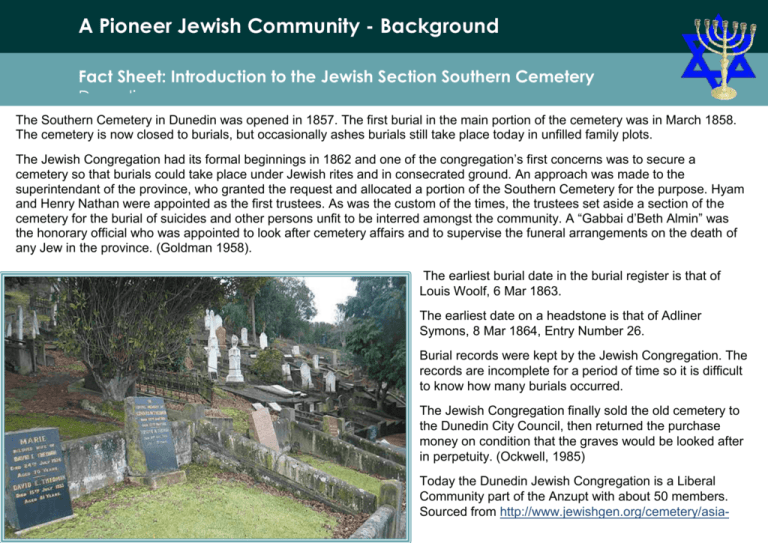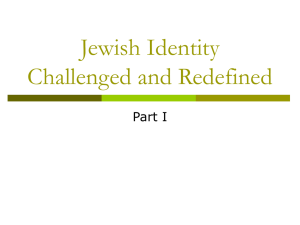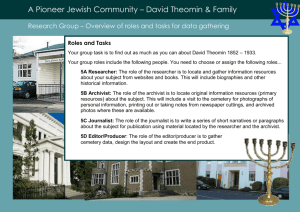2.Pioneer Jewish Unit - Historic Cemeteries Conservation Trust
advertisement

A Pioneer Jewish Community - Background Fact Sheet: Introduction to the Jewish Section Southern Cemetery Dunedin The Southern Cemetery in Dunedin was opened in 1857. The first burial in the main portion of the cemetery was in March 1858. The cemetery is now closed to burials, but occasionally ashes burials still take place today in unfilled family plots. The Jewish Congregation had its formal beginnings in 1862 and one of the congregation’s first concerns was to secure a cemetery so that burials could take place under Jewish rites and in consecrated ground. An approach was made to the superintendant of the province, who granted the request and allocated a portion of the Southern Cemetery for the purpose. Hyam and Henry Nathan were appointed as the first trustees. As was the custom of the times, the trustees set aside a section of the cemetery for the burial of suicides and other persons unfit to be interred amongst the community. A “Gabbai d’Beth Almin” was the honorary official who was appointed to look after cemetery affairs and to supervise the funeral arrangements on the death of any Jew in the province. (Goldman 1958). The earliest burial date in the burial register is that of Louis Woolf, 6 Mar 1863. The earliest date on a headstone is that of Adliner Symons, 8 Mar 1864, Entry Number 26. Burial records were kept by the Jewish Congregation. The records are incomplete for a period of time so it is difficult to know how many burials occurred. The Jewish Congregation finally sold the old cemetery to the Dunedin City Council, then returned the purchase money on condition that the graves would be looked after in perpetuity. (Ockwell, 1985) Today the Dunedin Jewish Congregation is a Liberal Community part of the Anzupt with about 50 members. Sourced from http://www.jewishgen.org/cemetery/asiapac-ind/newzealand.html A Pioneer Jewish Community Trail: Location of graves Jewish Section Southern Cemetery Dunedin A cemetery visit is encouraged but is optional for this activity as the number of graves to be visited as part of the study is quite small. One of the selected members of this Jewish Community study, Emily Siedeberg-McKinnon, is buried in the Northern cemetery in a family grave. She is not mentioned on the tombstone. An alternative to a class cemetery visit is for those 8 or so students who are the group editors/producers as these students need to wait on other students to gather information and could use the start time to photograph or film the graves. A parent could accompany students. The following trail map has been put together for that purpose. A second alternative is that students could be encouraged to visit independently. Tombstones and their locations are included in the resource kits. For some excellent background information on Dunedin’s early Jewish Congregation see the detailed article printed in the Otago Witness and available online from Papers Past http://paperspast.natlib.govt.nz/ The article can be searched for using the following keywords. “DUNEDIN HEBREW CONGREGATION”. Otago Witness, 3 April 1901. A Pioneer Jewish Community Trail: Location of study graves Jewish Section Southern Cemetery Dunedin 8 Septimus Myers Plot 110 Mark & Sarah Cohen Plot 88 7 3 1 6 Maurice Joel, Plot 144 2 2 8 3 The Theomins The PlotTheomins 124 Plot 124 7 1 6 4 Bendix Hallenstein & Willi Fells Plot 140 Jewish section Map reproduced from Ngaire Ockwell. (1985). Southern Cemetery Dunedin. Vol 5. Jewish and Chinese Portion. Member of the New Zealand Society of Genealogists. 4 A Pioneer Jewish Community – Jewish Calendar Fact Sheet: Those who visit the cemetery will notice that the headstones in the Jewish section of the cemetery, particularly those older headstones, have Hebrew as well as English text incised into the stone. This text tells who has died and when. Notice also that the date of death incised on the headstone is quite different. Students can speculate and find out why these headstones might be different. Numbering of Jewish Years The year number on the Jewish calendar represents the number of years since creation, calculated by adding up the ages of people in the Bible back to the time of creation. However, this does not necessarily mean that the universe has existed for only 5700 years as we understand years. Many Orthodox Jews will readily acknowledge that the first six "days" of creation are not necessarily 24-hour days. The Jewish Months of Year Hebrew English Nissan (Passover occurs) Length 30 days Month Equivalent March -April Iyar 29 days Aprl-May Sivan Tammuz 30 days 29 days May - June June - July Ab Elul 30 days 29 days July - August August - September Tishrei ( Jewish New Year) Cheshvan Kislev 30 days September - October 29 or 30 days 29 or 30 days October - November November - December Tevet 29 days December - January Shevat Adar I (leap years only) 30 days 30 days January - February February - March Adar Called Adar II in leap years 29 days February - March A Pioneer Jewish Community - jigsaw activity Phase 1 Activity One: Assigning groups and investigative roles to students A jigsaw approach is an ideal learning strategy to apply to a study of an early Jewish community. For more information about using the jigsaw approach in teaching and learning see Instructional Strategies Online at http://olc.spsd.sk.ca/DE/PD/instr/strats/jigsaw/ 1. Assign each student a number and a letter as follows. (This arrangement is for a class of 32 – adjust numbers for smaller classes. Some of the research roles can be joined together – e.g. the journalist and editor roles can be joined. Alternatively you can eliminate one of the expert groups e.g. Group 8) Group A: Student 1A, Student 2A, Student 3A, Student 4A. Group B: Student 1B, Student 2B, Student 3B, Student 4B. Group C: Student 1C, Student 2C, Student 3C, Student 4C. Group D: Student 1D, Student 2D, Student 3D, Student 4D. Group E: Student 5A, Student 6A, Student 7A, Student 8A. Group F: Student 5B, Student 6B, Student 7B, Student 8B. Group G: Student 5C, Student 6C, Student 7C, Student 8C. Group H: Student 5D, Student 6D, Student 7D, Student 8D. The students labeled 1 are part of the same “expert” group. The students labeled 2 are part of another “expert” group, and so on. There are enough resources for 8 expert groups. Provide each of these student teams with a resource starter kit and have the students select the role they are going to take. If you have 4 students in a group then students can select one of the following data gathering or presenting roles. 1A Researcher: The role of the researcher is to locate and gather information resources about the subject from websites and books. This will include biographies and other historical information. 1B Archivist: The role of the archivist is to locate original information resources (primary resources) about the subject. This may include a visit to the cemetery for photographs for inscription information, printing out or taking notes from newspaper cuttings, and locating archived photos where these are available. 1C Journalist: The role of the journalist is to write a series of short narratives or paragraphs about the subject for publication using material located by the researcher and the archivist. The journalist can assist the researcher in the initial stages and vice versa in the final stages. 1D Editor/Producer: The role of the editor/producer is to gather cemetery data and to design the layout and create the end product. The editor producer can assist the archivist in the initial stages and vice versa in the final stages. A Pioneer Jewish Community - Jigsaw activity Phase 1 Activity Two: Using the resource starter kits 2. Students begin work with members of their “expert” group that is the four students with the same number in their title. They research their individual in their assigned roles. 3. Students in expert groups prepare mini-posters or presentations. These posters/presentations can contain important facts, information, and images related to the study topic. Resource starter kits have been put together on each of eight members of the early Dunedin Jewish community. Within these starter kits are links to websites for resources and clippings from the online newspapers where events of the time have been recorded. Starter kits have been developed to ease time constraints where students might spend too long on data gathering. These kits have also been put together to allow for the different amount of material that is available for different people or where there is a lot of material available that might present overload problems for students. They also provide a model for teachers wishing to launch a historical cemetery study in a Jewish area other than Dunedin. Resource starter kits are available for the following individual members of the Dunedin Jewish Congregation. 1. Bendix Hallenstein 2. Maurice Joel 3. David Theomin and family 4. Samuel Saltzman 5. Emily Siedeberg-McKinnon 6. Willi Fels 7. Mark and Sarah Cohen 8. Septimus Myers Note: All members of the list above have been included because they have been buried in Dunedin cemeteries. All have headstones that can be visited in the Jewish portion of Dunedin’s Southern Cemetery except for Emily Siedeberg-McKinnon. She has been included because she was a woman and represents a certain freedom of spirit that existed among women and particularly Jewish women of the 1880s to 1920s. Other important figures to both Dunedin, and New Zealand’s past, include Julius Vogel and Ethel Benjamin. Both have been excluded due to their places of burial outside of Dunedin. Providing all the material in each starter kit to students is also optional. Some teachers may wish to have students search for the specific newspaper clippings as part of developing student searching skills in online searchable archives. A Pioneer Jewish Community – Jigsaw Activity Phase 2 Activity Two: Resource starter kits 4. Students return to their “home” or alphabetical teams and take turns presenting the material gathered in their expert groups to their team members. All the A’s should make one team, all the B’s another team etc. Students in phase 2 or alphabetical teams are to develop mind maps where they explore an early Jewish community in New Zealand in one of the following areas: Groups A and E: Explore the roles and responsibilities of selected members of the Jewish community and their families both in their daily life and in the wider community. In what ways did the members of the early Jewish community sustain their culture. Explore the values and perspectives that are both the same and different. (Identity, Culture and Organisation). Groups B and F: Explore the ways in which various selected members of the Jewish community were involved in the social issues of the times and ways they participated in social action events and activities. (Place and environment). Groups C and G: Explore the ways in which many of the selected members of the Jewish community kept faith with traditional customs but were also responsible for initiating changes to Dunedin and the wider New Zealand society and improving the well being of the community in general. (Continuity and change). Groups D and H: Explore the role of various selected members of the Jewish community in establishing a strong economic base in early Dunedin. What were some of the ways in which members of the early Jewish community participated in developing the greater New Zealand community. (The Economic World). For more information on developing a mind-map go to Mind-mapping Basic Rules http://www.teamwork.demon.co.uk/mind_maps/mind_basic.html and Mind-mapping applications http://www.teamwork.demon.co.uk/mind_maps/mind_apps.html#TOP Make sure students include the evidence from their research into individuals into their mind-maps that supports their thinking in each of the above areas. Each student group presents a short presentation based on their mind-map findings. A Pioneer Jewish Community Additional Resources for teachers to support this unit Try and make the following resources available for your class for this unit. Books Goldman, L.M. (1958). The History of the Jews in New Zealand. Wellington: AH and AW Reed. Levine, Stephen. (1999). The New Zealand Jewish Community. Lanham, Maryland: Lexington. Rosenthl Odeda (1988). Not strictly Kosher: Pioneer Jews in New Zealand. New York: Starchand Press. Thomson, Jane. (1998). Southern People: A dictionary of Otago Southland biography. Longacre Press in association with Dunedin City Council, Dunedin, N.Z. Williams, Tony. (2006). 101 ingenious Kiwis: How New Zealanders changed the world. Auckland: Reed. Websites The Jews 19th Century Migration http://www.teara.govt.nz/NewZealanders/NewZealandPeoples/Jews/1/en The Dictionary of New Zealand Biography http://dnzb.govt.nz/dnzb/ Papers Past: National Library http://paperspast.natlib.govt.nz/ Timeframes http://timeframes.natlib.govt.nz/ (For images of individuals. Search by individual name.) Libraries and Archives If your students have time available for additional research there are further resources available at the Hocken Library, the Settlers Museum and the McNab Room, Dunedin Public Library. Cemetery maps of the Jewish Section of Dunedin’s Southern Cemetery are used with permission. In Ngaire Ockwell (1985). Southern Cemetery Dunedin. Vol 5. Jewish and Chinese Portion. Member of the New Zealand Society of Genealogists. Other Jewish Cemeteries in New Zealand There are extensive Jewish sections in other New Zealand Cemeteries. Linwood cemetery in Christchurch is an excellent example.






